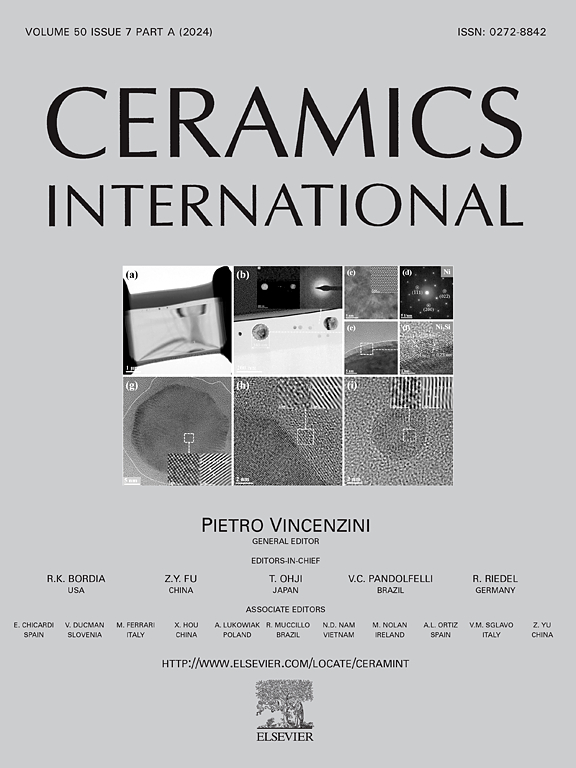小极化子对La2(Zr0.7Ce0.3)2O7/LaMnO3复合陶瓷高温热辐射屏蔽性能的影响
IF 5.1
2区 材料科学
Q1 MATERIALS SCIENCE, CERAMICS
引用次数: 0
摘要
稀土锆酸盐陶瓷材料熔点高,高温相稳定性好,在热障涂层中具有良好的应用前景。然而,由于工作温度的不断提高,稀土锆酸盐陶瓷材料在高温下对热辐射几乎是透明的,其导热系数的增加大大削弱了其绝缘性能。本研究针对稀土锆酸盐陶瓷材料在高温下对热辐射屏蔽效果较差的问题,在La2(Zr0.7Ce0.3)2O7中加入具有小极化子的LaMnO3作为吸收第二相,制备La2(Zr0.7Ce0.3)2O7/LaMnO3复合陶瓷。评价了La2(Zr0.7Ce0.3)2O7/LaMnO3的晶体结构、微观结构和红外发射率,研究了La2(Zr0.7Ce0.3)2O7/LaMnO3对高温光子导热性能的影响。La2(Zr0.7Ce0.3)2O7/LaMnO3复合陶瓷具有焦绿石和钙钛矿双相结构,晶粒分布均匀,晶界清晰。高温下,随着第二相(LaMnO3)含量的逐渐增加,La2(Zr0.7Ce0.3)2O7/LaMnO3在3 ~ 5 μm波长范围内的平均红外发射率从0.71增加到0.92,减小了光子导热系数对整体导热系数的影响。为了了解La2(Zr0.7Ce0.3)2O7/LaMnO3复合陶瓷材料的高吸收机理,建立了LaMnO3小极化子跳变模型。LaMnO3的电导率与温度呈线性关系,证明了LaMnO3在高温下具有小极化子的光吸收效应和对近红外辐射的高吸收性能。本文章由计算机程序翻译,如有差异,请以英文原文为准。
Effects of small polarons on the high-temperature thermal radiation shielding properties of La2(Zr0.7Ce0.3)2O7/LaMnO3 composite ceramics
Rare-earth zirconate ceramic materials have a high melting point, high-temperature phase stability and good application prospects in thermal barrier coatings. However, owing to the continuous improvement in the working temperature, rare-earth zirconate ceramic materials are nearly transparent to thermal radiation at high temperatures, and an increase in their thermal conductivity considerably impairs their insulation performance. In this study, considering the poor shielding effects of rare-earth zirconate ceramic materials on thermal radiation at high temperatures, LaMnO3 with small polarons was added to La2(Zr0.7Ce0.3)2O7 as an absorptive second phase to prepare La2(Zr0.7Ce0.3)2O7/LaMnO3 composite ceramics. The crystal structure, microstructure and infrared emissivity of La2(Zr0.7Ce0.3)2O7/LaMnO3 were evaluated, and the effects of La2(Zr0.7Ce0.3)2O7/LaMnO3 on the thermal conductivity of high-temperature photons were studied. The La2(Zr0.7Ce0.3)2O7/LaMnO3 composite ceramics possessed a dual-phase structure comprising pyrochlore and perovskite, demonstrating uniform grain distribution and clear grain boundaries. At high temperatures, with a gradual increase in the second-phase (LaMnO3) content, the average infrared emissivity of La2(Zr0.7Ce0.3)2O7/LaMnO3 in the wavelength range of 3–5 μm increased from 0.71 to 0.92, which reduced the impact of photon thermal conductivity on the overall thermal conductivity. To understand the high-absorption mechanism of the La2(Zr0.7Ce0.3)2O7/LaMnO3 composite ceramic materials, a LaMnO3 small-polaron-hopping model was established. A linear relationship between temperature and conductivity of LaMnO3 was established, which proved that LaMnO3 exhibited the light absorption effect of small polarons and high absorption performance for near-infrared radiations at high temperatures.
求助全文
通过发布文献求助,成功后即可免费获取论文全文。
去求助
来源期刊

Ceramics International
工程技术-材料科学:硅酸盐
CiteScore
9.40
自引率
15.40%
发文量
4558
审稿时长
25 days
期刊介绍:
Ceramics International covers the science of advanced ceramic materials. The journal encourages contributions that demonstrate how an understanding of the basic chemical and physical phenomena may direct materials design and stimulate ideas for new or improved processing techniques, in order to obtain materials with desired structural features and properties.
Ceramics International covers oxide and non-oxide ceramics, functional glasses, glass ceramics, amorphous inorganic non-metallic materials (and their combinations with metal and organic materials), in the form of particulates, dense or porous bodies, thin/thick films and laminated, graded and composite structures. Process related topics such as ceramic-ceramic joints or joining ceramics with dissimilar materials, as well as surface finishing and conditioning are also covered. Besides traditional processing techniques, manufacturing routes of interest include innovative procedures benefiting from externally applied stresses, electromagnetic fields and energetic beams, as well as top-down and self-assembly nanotechnology approaches. In addition, the journal welcomes submissions on bio-inspired and bio-enabled materials designs, experimentally validated multi scale modelling and simulation for materials design, and the use of the most advanced chemical and physical characterization techniques of structure, properties and behaviour.
Technologically relevant low-dimensional systems are a particular focus of Ceramics International. These include 0, 1 and 2-D nanomaterials (also covering CNTs, graphene and related materials, and diamond-like carbons), their nanocomposites, as well as nano-hybrids and hierarchical multifunctional nanostructures that might integrate molecular, biological and electronic components.
 求助内容:
求助内容: 应助结果提醒方式:
应助结果提醒方式:


